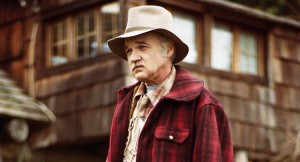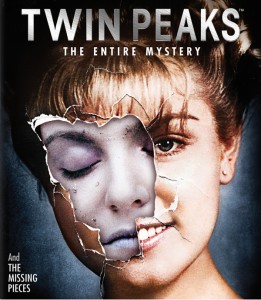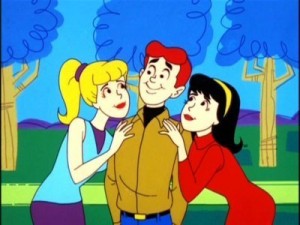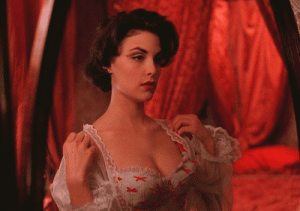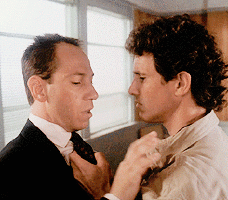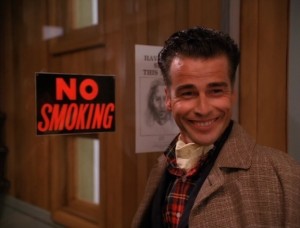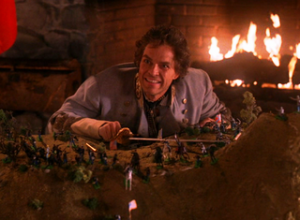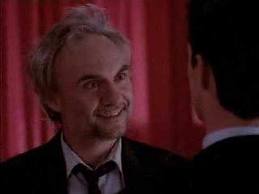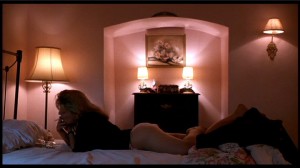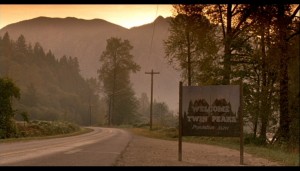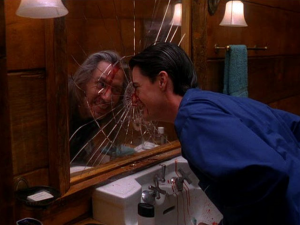My column for the April 2015 issue of Caimán Cuadernos de Cine. Although I didn’t have the space to discuss this, it seems to me in retrospect that Jack Nance, even as a relatively minor character (Pete Martell), is as much the realistic backbone of Twin Peaks as he is the realistic anchor of Eraserhead — and, as such, he stands at the opposite end of the spectrum from such supernatural pasteboard characters as Bob (Frank Silva) and Windom Earle (Kenneth Welsh). — J.R.
The news that David Lynch and Mark Frost are preparing nine new Twin Peaks episodes — all to be directed by Lynch and set in the present, and to air on cable TV’s Showtime in 2016 — has coincided with the release of a beautifully designed Blu-Ray box set with ten discs, Twin Peaks: The Entire Mystery and The Missing Pieces, devoted to the 29 episodes broadcast in 1990 and 1991 and the subsequent prequel theatrical feature, Twin Peaks: Fire Walk with Me (1992), and many extras. All this has prompted a re-evaluation of the series as a whole, which I’ve now seen in its entirety for the first time. A few critics have aided me in this quest—especially Michel Chion in his 1992 French book on Lynch, Martha P. Nochimson’s 1997 The Passion of David Lynch, and many fellow contributors to a 1995 American critical anthology edited by David Lavery called Full of Secrets: Critical Approaches to Twin Peaks.
My own contribution to the latter was a somewhat skeptical consideration of the puritanical and politically innocent underpinnings of the show’s first season. What gave me pause about the series in 1990 was the combined public perception that it was both subversive and somehow free of (or at least irrelevant to) ideology, a common American fallacy (cf. Tarantino, the Coen brothers, Argo, et al.) Although I enjoyed the transmutation of Archie Comics and much of the rest of the Eisenhower 50s into the George H.W. Bush 90s, with blonde Betty turned into Laura Palmer and dark Veronica replaced by Audrey Horne (Betty’s doppelgänger, even when it comes to the specter of parental incest), I couldn’t help but wonder about the adolescent and reactionary (as well as class-based) notions of evil that came with the package. The New Age pretensions seemed to both preclude and replace any sort of political analysis of what was troubling this repressive community, and if a wizened city slicker like Albert Rosenfield — perhaps significantly, the only probable Jew in sight — never quite attained the status of villain, he still had to be punched out by the virtuous Sheriff Harry S. Truman and humbled by the hero, his FBI colleague Dale Cooper, before he could be accepted as part of the community.
The second season, despite some additional thrills, only made things worse by trafficking in arbitrary goofiness without Lynch’s poetics. Chion rightly describes Twin Peaks as “a harem where everyone, as Serge Daney put it in the first issue of his journal Trafic, ‘gives you a hard on.’” But I seriously wonder whether Daney would have responded that way to Dick Tremayne, the ludicrously affected dandy who becomes Deputy Andy Brennan’s romantic rival for the hand of Lucy Moran, or even Ben Horne after he goes crazy and thinks he’s Robert E. Lee (or, even worse, after he “recovers” and decides to become an “honest” environmentalist.) The crucial difference between these grotesqueries and those in the show’s first season, before it slipped beyond Lynch’s influence and control, is that they constitute insults to the gullibility of the audience, and the same can be said of the cackling villain Windom Earle, who seems to belong more to the festive nihilism of the Batman blockbusters. Even though Lynch’s direction of the 9th, 10th, and 15th episodes and Fire Walk with Me restored some of his poetics, the adolescent sentimentality that had also marred for me much of Blue Velvet and Wild at Heart seemed to predominate.
The extras on the box set testify to many of the resulting confusions while clarifying other and better directions that the latter episodes might have taken. At one point, we see Lynch himself interviewing the three members of the Palmer family (two of them now dead for 25 years) in black and white, over plates of cherry pie, and then, in full color, interviewing the same three actors as actors about Twin Peaks in the same setting. We also get 90-odd minutes of outtakes from Fire Walk with Me, some of which suggest that this prequel lost a lot of narrative coherence and fine acting without them.

